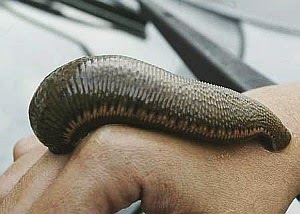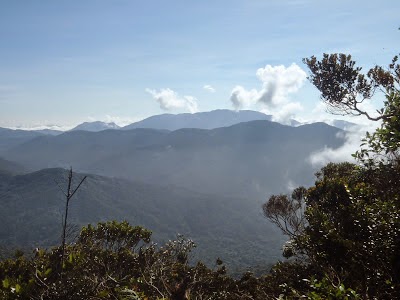Map of Sabah, the "doghead-like" Borneo state of Malaysia.
Sipadan Island which offers some of the world's best diving sites.
The expedition that formed this trip were myself, Ian, Peter, Alex & Rajpal. By now, all five of us would have had some mountaineering experience after hiking up some of peninsular Malaysia's G7 mountains. Mt. Kinabalu was the highest peak attempted by any of us at that point in time. Peninsular Malaysia's G7 were less than half its elevation.
We arrive in the capital of Sabah, Kota Kinabalu formerly known as "Jesselton" via a 2.5 hour Air Asia flight from KL. Spirits were high and we were all excited when we arrived in the "Land Below the Wind". It was also my first time in Sabah and Borneo despite it being an integral part of Malaysia!
Some light rain greeted us in Kota Kinabalu as it was the rainy monsoon season then. The monsoon season in the west coast of Sabah lasts from November to February and rains can be very heavy causing severe flooding during this bad weather period. It was not very wise of us to plan an attempt on Malaysia's highest peak during this bad weather period indeed. Nevertheless, our excitement at an attempt to conquer Malaysia's highest point outshined the gloomy weather.
We stayed in a backpackers lodge in the middle of town that night and would depart via bus to the foot of the mountain the next morning. The rain simply poured all night long signalling an unfavourable start to the journey. All we could do is hope that the next day would be a sunnier one.
Morning arrived but the sun's rays were dim as a thick gray overcast hid most of the sun from the land...not a good sign for a start. Anyways, we had a quick breakfast and departed by bus to the foothill of the mountain. That journey through the Sabah highlands was a mesmerizingly beautiful one! The roads however, were narrow and winding and seemed unsafe at certain bends. Despite being one of Malaysia's most resource rich state, Sabah is still evidently impoverished in certain areas and still lack basic infrastructure such as tarred roads, electricity and clean water supply in the interior regions...how ironic. After a winding 2.5 hour journey through the mountains, we arrived at the Kinabalu Park headquarters, the is the very place where we get our guides and start our hike up the mountain. We paid up all necessary park fees, guide fees, insurance fees etc..and met up with our guide who is a minute pint sized Kadazan-dusun man named Mosilus. It was not a very ideal start for us time-wise as we arrived late in the morning at around 1030am and registration, payment etc took about an hour long. There are a few trails that lead up to the summit and the most popular one is the Timpohon trail being the shorter one and the other trail is the Mesilau trail which is the longer and more challenging trail. There is another least popular alternative trail called via Ferrata which requires technical climbing skills as rock climbing techniques are required to climb up the rockier side of the mountain. We took the Mesilau route for a challenge.
At the trailhead of the Mesilau Trail in the Kinabalu Park HQ.
The trek through the lower elevations of the mountain was a very refreshing one as cool mountain air from the lush greenery of the surrounding rainforest gave our oxygen-deprived "city" lungs some much needed cleansing. Although the Mesilau trail is much longer than the Timpohon trail, the consolation is that its steps are not as big because Timpohon goes up the steeper but shorter part of the mountain. One of the bad things of starting late is that you have less weather window and the bad weather starts coming in faster by noon. Thats exactly what happened to us. To make things worse I didn't even have a raincoat! By noon onwards, the clouds came in so did the rain and we were all battling the cold and the poor visibility. I was suffering from leg cramps as a result of the cooling down of my leg muscles by the rain. Alex and Rajpal were also suffering from these cramps. Due to my legs cramping very badly, I had to take many breaks in between and exposing myself to the pouring rain even more. I had to literally take baby steps up the mountain. After a 7 hour slog, we finally reached mid-way point which was where our shelter for the night is located, Gunting Lagadan hut. At that time, this mountain hut had no heating or even hot water. It was simply a roof over the head. The Laban Rata hut is a much better choice as it has heating and warm water in the showers. Choosing Gunting Lagadan didn't seem to be the right choice now that we were all soaking wet and shivering from the cold.
Soaking wet by dusk in front of the Laban Rata mountain hut.
Drenched and weary after a day climbing through pouring rain. In Laban Rata guesthouse.
We had our dinner in Laban Rata which was crowded like a "pasar malam" (night market) and didn't even have a proper place to sit because there were tired hikers suffering from fatigue all over the place. The entire dinning hall had a "sweaty" stench as these late arrivals would just drop dead on the floor to take a few minutes of nap to regain composure. Dinner wasn't palatable that night and I didn't eat much to replenish the much needed energy for tomorrow's summit attempt. We hiked back up to Gunting Lagadan which was located at a slightly higher elevation from Laban Rata, after dinner to get some much needed rest for the night. Unfortunately for me I had a high fever that night after being exposed to the soaking rain and wind chill for the entire day. I couldn't sleep at all that whole night and was feeling nauseous. Things were not looking good for me. At 230am, Mosilus the guide came knocking at our doors as we had to depart early for the summit attempt in order to catch a glimpse of the supposed sunrise and more importantly to avoid the clouds coming in by late morning. There were already a few deaths on the mountain and the latest was that of a British girl who lost her way on the summit plateau because the cloud cover came in so fast and she strayed away from the main trail due to poor visibility. Her body was found a week later and post mortem showed that she died of hypothermia. Aki Nabalu which is what Mt. Kinabalu derives its name from means "Abode of the Dead" in the Kadazan-dusun language. We certainly didn't want to be permanent residents of this abode although the scenery from up here might be quite beautiful.
The weather was again not on our side that morning, the God of the Rain summoned the clouds to continue pouring rain water on us. The climb up Kinabalu's rock face became a climb up a waterfall literally! Water was simply gushing down from the rocky trail ahead adding to the challenge of the already poor visibility and bone freezing wind chill. My condition became from bad to worse, and the bad weather was not helping my high fever get any better. I was like a drunkard climbing up the mountain just that I was not drinking. We arrived at the Sayat-Sayat huts (3668m), which was the last check point on the mountain.
By this time I was almost completely drained of my energy and sanity. I was literally like a crazy drunk guy on the mountain and I even started hearing things in my ear...probably those "Abode of the Dead" people welcoming me to their beautiful home. Alex's condition wasn't good either as he was equally drained of energy. The summit was approximately 3 more hours away from this point (assuming in good weather). Our group had a quick discussion among ourselves. Since my condition was not improving and it was a risk for me to proceed further in a partially concious condition I opted to go no further than the Sayat-Sayat checkpoint. Alex also decided to stay put as he was in a similar condition as I was. Peter, Ian and Rajpal would proceed for the summit attempt in harsh weather conditions while Alex and I simpy KO-ed in a telephone booth at Sayat-Sayat, yeah thats right a telephone booth! London style...don't ask me why there's such a thing on that point of the mountain. We slept in the telephone booth to regain composure while waiting for the daring trio to summit and come back down.
According to Ian's account, the climb up the summit was treacherous as the summit plateau was exposed to the stormy winds and the rain water droplets hindered vision, making the eyes very sore as it hit. Despite the bad weather, the trio made sturdy baby steps all the way to Low's Peak (4095.4m) which is the summit of Mt. Kinabalu and highest point in Malaysia. Well done to them! However that very day about half of the climbers turned back and didn't make it to the top due to the harsh weather (according to the checkpoint).
Ian on the summit plateau with South Summit in the backdrop. The wind had simply blown his raincoat apart.
Ian in front of the famed "Donkey Ears" on the summit plateau.
The trio met up with myself and Alex who were lying "partially dead" in the telephone booth while descending from the summit and we made our way down to Gunting Lagadan. Once back at the mountain hut, I jumped on the bed to have a much needed nap. By 11am we had to pack up and leave the mountain hut as that was the check out time. We made our descend through the Timpohon trail. It was a knee jerking descend as the steps were relatively big/high hence putting a lot of pressure on the knees. We were out of the mountain in 3 hours time, and along the way we saw pint sized Kadazan-dusun guides making their journey up the mountain carrying baggage 3X their size on their heads! That really put me to shame!
Our expedition team at Laban Rata on the descend.
To date Mt. Kinabalu remains the only mountain that defeated me on that very climb. It was due to several poor decisions from climbing during the peak of monsoon, to not bringing a raincoat, to choosing that unheated hut (Gunting Lagadan) and not eating enough. This failed trip for me was certainly a blow to my mountain climbing ambitions and put me on the backseat to do some self reflection before planning for future climbs. One thing I learned is that there's no easy mountain! Even though there could be thousands of tourists from the old to the young summiting Mt. Kinabalu every year, it doesn't mean that this mountain is an easy one. A mixture of the wrong conditions would create a recipe for disaster and I learned it the hard way. Thankfully there were no injuries to anyone or it could have been much worse and probably put an early end to my mountain climbing days. Kinabalu was a great teacher to me and a reminder that the will of man is nothing in the face of nature's fury!
Mt. Kinabalu hiding behind the clouds as seen from Kota Kinabalu.
























